| Listing 1 - 10 of 14 | << page >> |
Sort by
|
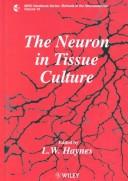
ISBN: 0471975052 Year: 1999 Publisher: Chichester ; New York : Wiley,
Abstract | Keywords | Export | Availability | Bookmark
 Loading...
Loading...Choose an application
- Reference Manager
- EndNote
- RefWorks (Direct export to RefWorks)
Nerve tissue --- Neurons --- Cultures and culture media --- Laboratory manuals. --- Growth

ISBN: 0444502882 Year: 1999 Publisher: Amsterdam : Elsevier,
Abstract | Keywords | Export | Availability | Bookmark
 Loading...
Loading...Choose an application
- Reference Manager
- EndNote
- RefWorks (Direct export to RefWorks)
Efferent pathways. --- Interneurons. --- Locomotion. --- Motor Neurons --- Motor neurons. --- Movement. --- Nerves, Peripheral. --- Neuromuscular transmission. --- Peripheral Nervous System --- Spinal Cord --- Spinal cord --- physiology. --- Physiology.
Dissertation
Year: 1999 Publisher: Liège Université de Liège
Abstract | Keywords | Export | Availability | Bookmark
 Loading...
Loading...Choose an application
- Reference Manager
- EndNote
- RefWorks (Direct export to RefWorks)
Signal Transduction --- Neurons --- Neuroglia --- Neural Cell Adhesion Molecules --- Nerve Regeneration --- physiology --- genetics
Dissertation
ISBN: 9039321159 Year: 1999 Publisher: Utrecht Universiteit Utrecht
Abstract | Keywords | Export | Availability | Bookmark
 Loading...
Loading...Choose an application
- Reference Manager
- EndNote
- RefWorks (Direct export to RefWorks)
Apoptosis --- Motor Neurons --- Antioxidants --- Reactive Oxygen Species --- Tissue Extracts --- drug effects --- physiology --- pharmacology
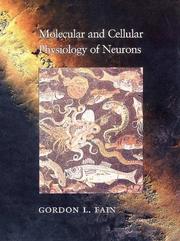
ISBN: 0674581555 9780674581555 Year: 1999 Publisher: Cambridge, Massachusetts Harvard University Press
Abstract | Keywords | Export | Availability | Bookmark
 Loading...
Loading...Choose an application
- Reference Manager
- EndNote
- RefWorks (Direct export to RefWorks)
Biomembranes --- Neurons --- Molecular Biology. --- Neurobiology. --- Neurophysiology. --- Neurons. --- Molecular neurobiology. --- Neurones --- Neurophysiologie --- Neurobiologie moléculaire --- physiology. --- Neurobiologie moléculaire --- Molecular neurobiology --- Neurophysiology --- Nervous system --- Nerve cells --- Neurocytes --- Molecular neurology --- Physiology --- Molecular aspects --- Neurobiology --- Cells --- Molecular biology
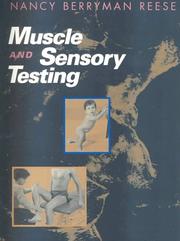
ISBN: 0721659586 Year: 1999 Publisher: Philadelphia (Pa.) : Saunders,
Abstract | Keywords | Export | Availability | Bookmark
 Loading...
Loading...Choose an application
- Reference Manager
- EndNote
- RefWorks (Direct export to RefWorks)
Afferent pathways --- Applied kinesiology. --- Muscle Tonus. --- Muscle Weakness --- Muscle strength --- Muscles --- Nervous System Physiology. --- Nervous System --- Physical therapy. --- Sensory neurons --- Testing. --- diagnosis. --- physiology. --- physiopathology.

ISBN: 0521622166 1280418842 0511152515 0511327552 9786610418848 1139164260 0511050496 051117344X 0511019610 9780511019616 9780521622165 0521627265 9780521627269 051103525X 9780511035258 9780511173448 9781139164269 1107114926 Year: 1999 Publisher: Cambridge Cambridge University Press
Abstract | Keywords | Export | Availability | Bookmark
 Loading...
Loading...Choose an application
- Reference Manager
- EndNote
- RefWorks (Direct export to RefWorks)
This new edition of Nerve Cells and Animal Behaviour has been updated and expanded by Peter Simmons and David Young in order to take into account more recent advances while still maintaining the accessibility of the book to university students. The book introduces the reader to the way in which nervous systems of animals control behaviour without assuming any prior knowledge of neurophysiology. Using a carefully selected series of behaviour patterns students are taken from an elementary-level introduction to a point where sufficient detail has been assimilated to allow a satisfying insight into current research on how nervous systems control and generate behaviour. Only examples where it has been possible to establish a clear link between the activity of particular nerve cells and a pattern of behaviour have been used. This book is essential reading for students of zoology, psychology and physiology and serves as a clear introduction to neuroethology.
Animal behavior --- Neurons --- NEUROPHYSIOLOGY --- NEUROBIOLOGY --- Animal behavior. --- Neurobiology. --- Neurons. --- Neurophysiology. --- Neurobiology --- Neurophysiology --- Behavior, Animal --- Physiology --- Neurosciences --- Biology --- Behavior --- Biological Science Disciplines --- Behavior and Behavior Mechanisms --- Natural Science Disciplines --- Psychiatry and Psychology --- Disciplines and Occupations --- Neuroscience --- Human Anatomy & Physiology --- Health & Biological Sciences --- Nervous system --- Animals --- Animals, Habits and behavior of --- Ethology --- Nerve cells --- Neurocytes --- Animal psychology --- Zoology --- Ethologists --- Psychology, Comparative --- Cells
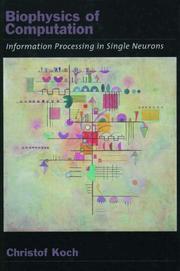
ISBN: 0197562337 1280595094 9786613624925 0199760551 9780199760558 0195104919 9780195104912 0195181999 9780195181999 9781280595097 6613624926 0190292857 9780197562338 Year: 1999 Publisher: New York Oxford University Press
Abstract | Keywords | Export | Availability | Bookmark
 Loading...
Loading...Choose an application
- Reference Manager
- EndNote
- RefWorks (Direct export to RefWorks)
Neural network research often builds on the fiction that neurons are simple linear threshold units, completely neglecting the highly dynamic and complex nature of synapses, dendrites, and voltage-dependent ionic currents. Biophysics of Computation: Information Processing in Single Neurons challenges this notion, using richly detailed experimental and theoretical findings from cellular biophysics to explain the repertoire of computational functions available to single neurons. The author shows how individual nerve cells can multiply, integrate, or delay synaptic inputs and how information can be encoded in the voltage across the membrane, in the intracellular calcium concentration, or in the timing of individual spikes. Key topics covered include the linear cable equation; cable theory as applied to passive dendritic trees and dendritic spines; chemical and electrical synapses and how to treat them from a computational point of view; nonlinear interactions of synaptic input in passive and active dendritic trees; the Hodgkin-Huxley model of action potential generation and propagation; phase space analysis; linking stochastic ionic channels to membrane-dependent currents; calcium- and potassium-currents and their role in information processing; the role of diffusion, buffering and binding of calcium, and other messenger systems in information processing and storage; short- and long-term models of synaptic plasticity; simplified models of single cells; stochastic aspects of neuronal firing; the nature of the neuronal code; and unconventional models of sub-cellular computation. Biophysics of Computation: Information Processing in Single Neurons serves as an ideal text for advanced undergraduate and graduate courses in cellular biophysics, computational neuroscience, and neural networks, and will appeal to students and professionals in neuroscience, electrical and computer engineering, and physics.
Computational neuroscience. --- Neurons. --- Neural networks (Neurobiology) --- Action potentials (Electrophysiology) --- Neural conduction. --- Conduction, Neural --- Nerve conduction --- Neurophysiology --- Electrophysiology --- Biological neural networks --- Nets, Neural (Neurobiology) --- Networks, Neural (Neurobiology) --- Neural nets (Neurobiology) --- Cognitive neuroscience --- Neurobiology --- Neural circuitry --- Nerve cells --- Neurocytes --- Cells --- Nervous system --- Computational neurosciences --- Computational biology --- Neurosciences --- Computational neuroscience --- Neural conduction --- Neurons
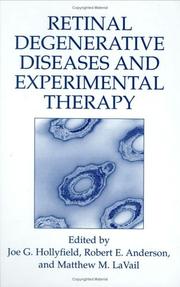
ISBN: 0306461935 0585331723 Year: 1999 Publisher: New York, New York : Kluwer Academic Publishers,
Abstract | Keywords | Export | Availability | Bookmark
 Loading...
Loading...Choose an application
- Reference Manager
- EndNote
- RefWorks (Direct export to RefWorks)
To create a forum for scientists and clinicians interested in degenerative retinal diseases, we began in 1984 to organize a biennial symposium on Retinal Degeneration as a satellite meeting of the International Congress of Eye Research. The timing and varying location of these meetings provides an important assembly for investigators from throughout the world to convene for presentation of their new findings on the causes and potential therapies for degenerative retinal disorders. The VIII International Symposium on Retinal Degeneration was held from July 28-25, 1998, at the Hotel Vier Jahreszeiten in Schluchsee, a small town in the Black Forest of southwestern Germany. Most of the participants in this meeting contributed to this volume, and we are appreciative of the efforts of each author in making this publication possible. The research presented at the meeting, and described in this proceedings volume, reflects a strong emphasis on the molecular genetic approach to understa- ing these disorders. Several of the papers provide important new insights into the mechanism of photoreceptor degeneration and cell death. A number of the studies are targeted at retarding or reversing the degeneration process. Included for the first time are presentations from all the principal laboratories involved in the field of visual prostheses-implant (chip) technology-in which investigations are targeted at restoring vision in eyes that have lost photoreceptor cells. A variety of diagnostic, clinical, histopathological, and physiological assessments of retinal degeneration in patients are also included.
Photoreceptors --- Retina --- Retinal Degeneration --- Retinal Degenetation --- Degeneration --- Treatment --- genetics --- physiopathology --- therapy --- Photoreceptors -- Congresses. --- Retinal degeneration -- Congresses. --- Retinal degeneration -- Treatment -- Congresses. --- Retinal Neurons --- Neurons, Afferent --- Photoreceptor Cells --- Retinal degeneration --- Medicine. --- Human genetics. --- Pharmacology. --- Human anatomy. --- Ophthalmology. --- Biomedical engineering. --- Medicine & Public Health. --- Human Genetics. --- Biomedical Engineering. --- Anatomy. --- Pharmacology/Toxicology. --- Toxicology. --- Biomedical Engineering and Bioengineering. --- Genetics --- Physiopathology --- Therapy --- Drug effects --- Medical pharmacology --- Medical sciences --- Chemicals --- Chemotherapy --- Drugs --- Pharmacy --- Anatomy, Human --- Anatomy --- Human biology --- Human body --- Clinical engineering --- Medical engineering --- Bioengineering --- Biophysics --- Engineering --- Medicine --- Heredity, Human --- Physical anthropology --- Eye --- Physiological effect --- Diseases --- Dystrophy, Retinal --- Macular degeneration --- Retinal dystrophy --- Degeneration (Pathology)

ISBN: 3540644601 3642636438 3642585523 9783540644606 Year: 1999 Publisher: Berlin: Springer,
Abstract | Keywords | Export | Availability | Bookmark
 Loading...
Loading...Choose an application
- Reference Manager
- EndNote
- RefWorks (Direct export to RefWorks)
Neuroscience has become a rapidly expanding young science that relies on a number of other sciences and their methods. For that reason it is a truly interdisciplinary and inter-methodological undertaking of much fascination to many. In this spirit, this book attempts at presenting an overview of the techniques currently used in modern neuroscience research. By doing so, it is also an introduction into neuroscience itself, from the angle of methods available to tackle prevailing questions. Many questions can only be answered by combining methods borrowed from different fields. Building on this insight, this book's organizing principle is the investigation of levels of the nervous system, from molecular and cellular to whole organisms. The reasons are twofold. First, certain organizational levels can be optimally studied and potentially understood only by applying an array of diverse techniques. Second, it is important to avoid succumbing to the danger of pure technicality, which might arise from ordering the description of techniques according to their inherent principles of coherence (e.g. staining vs. electrophysiological techniques). In addition, this book aims at providing a direct working tool for the user in the laboratory and clinic and thus addresses all active neuroscience researchers, from graduate students to supervisors. The main emphasis in terms of layout is on detailed step-by-step protocols including personal tips and recommendations. Most chapters or protocols are organized so that they can be used independently. Moreover, cross-references to other techniques in other chapters, which are aimed at studying the same object(s) from a different angle, help create the pertinent context.
Neurosciences --- Biological techniques --- Animal psychology and neurophysiology --- Research. --- TECHNIQUES --- Neurons. --- Neurosciences. --- Neural sciences --- Neurological sciences --- Neuroscience --- Medical sciences --- Nervous system --- Nerve cells --- Neurocytes --- Cells --- Science --- Science research --- Scientific research --- Information services --- Learning and scholarship --- Methodology --- Research teams --- Research --- Monograph --- Animal physiology. --- Animal Physiology. --- Animal physiology --- Animals --- Biology --- Anatomy --- Physiology --- Neurosciences - Laboratory manuals
| Listing 1 - 10 of 14 | << page >> |
Sort by
|

 Search
Search Feedback
Feedback About UniCat
About UniCat  Help
Help News
News